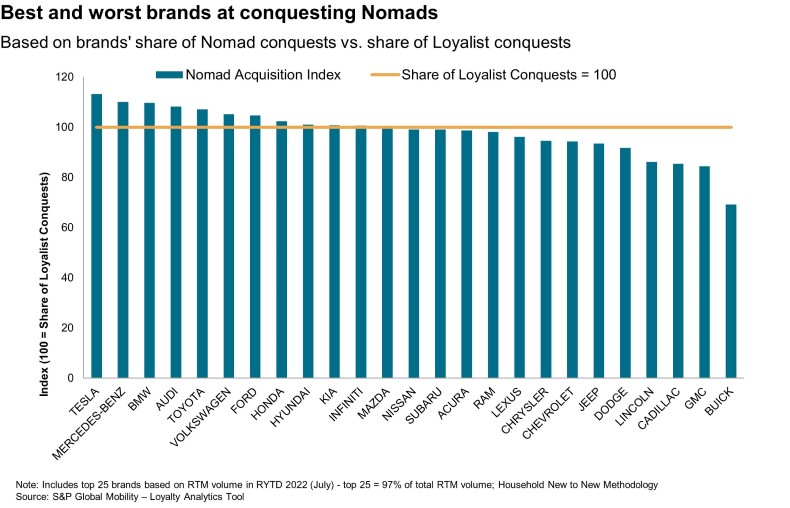Some brands may be good at stealing – politely called conquesting – customers from other brands. But do those conquested consumers become what S&P Global Mobility calls loyalists or are they nomads, buyers with no identifiable pattern of brand allegiance?
A new report by S&P Global Mobility looks at which brands successfully turn nomads into loyalists and how brands with a high level of “one-and-done” customers can improve their records. Some of that starts at the dealer level.
“Now you have a player in a brand people might not have considered before,” says Erin Gomez, associate director of consulting for S&P Global Mobility. “If you introduce a new product, you will bring in new customers but particularly nomads, who might consider a brand they didn’t consider before.”
Car dealers can do so by highlighting new products some shoppers might not associate with the brand.
S&P divides car buyers into three categories: nomads, who are first-time owners of a brand; loyalists, who buy a brand two times in a row; and super loyalists, who buy a brand three or more times in a row. “One-and-done” customers are a subset of nomads, Erin Gomez, associate director of consulting for S&P Global Mobility, tells Wards.
Nomads comprise more than half of the return-to-market population, says Gomez. “That is why this population of customers is so important. The sheer size and the potential to become loyalists,” she says.
S&P defines nomadic households as those that tend to skew toward the wealthiest families of highly educated professionals living in suburban neighborhoods with disposable income.
“Households that fit this profile could be high risk for one-and-done if they chase the latest trendy product,” says the report.
Tesla, Mercedes-Benz and BMW are the most successful automotive brands in conquesting nomads. Tesla also is best at keeping nomads loyal compared to the overall return-to-market population. Ram and Jeep rank second and third in maintaining loyal nomads; however, buyers of both brands also have a higher one-and-done rate than the industry.
Gomez says that indicates “Nomad retention is a challenge, but they have high loyalty.”
While Ram can turn nomads into loyalists, Gomez says its overall brand loyalty rate is relatively low. Conversely, Ford ranks low on the Nomad Loyalty Index but has fairly high brand loyalty. So, Ford is relatively less successful at turning nomads into loyalists but overall has more loyal customers.
Conquest, loyalty and conversion of previous buyers into loyal ones are all important, says S&P. Yet brands such as Ram, which have concentrations of nomads they may lose, should focus on converting previous buyers into loyal buyers.
What strategies can automakers employ to achieve that? For some brands, such as Hyundai, which, like Tesla, has a high share of nomads but a low one-and-done rate, introducing a model in a popular segment, like upper midsize utility vehicles, in which Hyundai previously didn’t play, is compelling.
For Ram, which only competes in the truck segment, another strategy may be successful, says Gomez. Ram is part of the Stellantis group, which includes about a dozen other brands.
“Ram may consider focusing on manufacturer loyalty to ensure the Nomads leaving the brand for a different body style stay within the Stellantis family,” she says.
The most important thing when considering how to turn nomads into loyalists, says Gomez, “is understanding your current customer base. How much of the customer base are you at risk of losing because they are nomadic? Also, understanding why people left the brand. If most are leaving for a segment you don’t play in, that is where potentially introducing a new model comes into play.”





